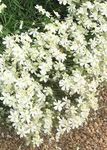Cgardener's notebook Horticultural News and Research Important to American Gardeners - American Horticultural Society
←
→
Page content transcription
If your browser does not render page correctly, please read the page content below
C
gardener’s notebook
Horticultural News and Research Important to American Gardeners
PLANT SELECT UNVEILS TOP 2020 PLANTS deep green foliage. Blooming May through summer, this dura-
With a mission to identify and distribute the most exceptional ble plant does well in hot, dry climates.
plants that thrive in the Rocky Mountain region, Plant Select, a A tidy, rounded perennial for early spring flowers, golden can-
nonprofit collaboration of Denver Botanic Gardens, Colorado dles (Thermopsis lupinoides) sends up abundant elegant golden can-
State University, and professional horticulturists, introduces top- dle spires of showy blooms well into June. Happy in full sun to light
performing plants to garden centers and wholesale suppliers each shade, this adaptable plant becomes drought-tolerant with maturity.
year. New for 2020 are seven plants that have been chosen for their Indigo blue dragonhead (Dracocephalum ruyschiana) is
superior robustness and ability to flourish in a range of conditions. an elegant mounding plant with dark blue flower spikes and
Dwarf leadplant (Amorpha nana) is a small native shrub needlelike leaves. An adaptable perennial tolerant of average
that bears spikes of honey-scented purple flowers in June. This soils, it blooms in early summer and thrives in rock gardens
dryland shrub thrives with full sun in dry, rocky soils. and dry meadow areas as well as average soils.
Mongolian snowflakes (Clematis hexapetala), a herbaceous Forming a dense mound of aromatic, soft, silvery-green
clematis, features small, six-petaled, ivory-colored flowers atop feathery leaves, Leprechaun southernwood (Artemisia abro-
tanum ‘Leprechaun’)
creates an attractive,
compact, low garden
hedge that can be
grown in full sun, part
shade, or full shade.
Pink cotton lamb’s
ear (Stachys lavandu-
lifolia Green Form)
features low mats of
soft green foliage with
spiky clusters of fuzzy
pink flowers resem-
bling cotton candy
that bloom in late
spring to early sum-
mer. Rabbit and deer
resistant, this plant
thrives in average to
Among Plant Select’s 2020 top dry soils.
performers for the Rocky Mountain And lastly, sum-
region are indigo blue dragonhead, top mer frost pink candy
left, dwarf lead plant, bottom left, and (Stachys lavanduli-
Mongolian snowflake, above. folia ‘P020S’, Silver
Form), is an elegant
silver-leaved form of lamb’s ear with similar cotton candy pink
flower spikes that bloom in late spring.
Learn more about all of these plants at https://plantselect.org/
plants/new-for-2020.
FILLING A NEED FOR MORE PLANTMOJI
COURTESY OF PLANT SELECT (3)
Strolling through the Missouri Botanical Garden’s (MOBOT)
2019 Orchid Show, Cassidy Moody, MOBOT’s Senior Digital
Media Specialist, snapped a photo of the display to share on
social media. To complement the photo, he naturally wanted
to use an emoji. However, despite being one of the two largest
44 the American Gardenerplant families on the planet—representing nearly 26,000 known
species—orchids (Orchidaceae) surprisingly do not have their
own dedicated emoji. Although there are flower emoji like the
hibiscus or sunflower, using a flower not in the same plant family
did not sit well with Moody. Disenchanted with the overall lack
of emoji diversity for the plant kingdoms, he decided to delve
into the emoji world and spearhead MOBOT’s push for an or-
chid emoji. “As a botanical garden striving to discover and share
knowledge of plants, we’d like to see more plants represented by
emoji, or what we’re calling plantmoji,” Moody notes.
Orchids make up a large category of flowering plants and come
in extraordinary diversity. As Moody states in his proposal to the
Unicode Consortium (the group that oversees the emoji selection
process), “this is not simply a
different species of plant but
represents an entire family of
flowering plants that is not rep-
resented by emoji.” Moreover,
orchids, Moody says “hold
meaning for many people be-
yond horticulture and botany.”
MOBOT decided to base its
orchid emoji design on the pop-
ular moth orchid (Phalaenopsis
Designed by Sam Balmer, sp.) to symbolize the vast or-
MOBOT’s proposed emoji depicts chid family.
a phalaenopsis orchid flower. MOBOT’s proposal has
passed the first rounds of ap-
proval, meaning the orchid emoji could potentially come to fru-
ition as soon as 2021. And there’s a good chance that this year’s
Experts trust the #1 brand in organic gardening
World Emoji Day, on July 17, will bring even more plantmoji. Laura LeBoutillier grew up working in her parents’ garden
Out of 117 new emoji proposed for 2020, five represent plants in center. Since then, she and her husband Aaron have
some form—bell pepper, blueberries, olive, wood, and potted published hundreds of inspirational and educational
plants. Now with the garlic and onion (Amaryllidaceae) emoji gardening videos online for over 2.4 million loyal fans.
added last year, there are 27 plant families represented.
Laura loves her garden and uses only the best products
Moody hopes MOBOT’s proposal encourages others to sub-
mit their own plantmoji and work toward expanding plants’ to ensure it looks beautiful. That’s why she trusts Espoma
digital diversity. According to Moody, “the natural world, and Organic® for her fertilizer and potting soil needs.
specifically the plant kingdom, needs to be represented digitally Espoma. A natural in the garden since 1929.
so its importance to life on earth is not overlooked.” And while
Moody realizes the digitized plants will never be substitutes for
the real ones, he notes that because digital communication is
increasingly important today, “plantmoji and other nature emoji
can be a powerful tool for someone waging a conservation cam-
paign, highlighting an endangered species, or simply calling at-
tention to the beauty around us.”
To read MOBOT’s proposal for the orchid emoji, visit
https://discoverandshare.org/wp-content/uploads/2w019/07/orchid-
emoji-proposal.pdf.
COURTESY OF MISSOURI BOTANICAL GARDEN
BULB SIZE MATTERS
A study published earlier this year in the journal Ecology and
Evolution offered insights into the evolution and ecology of
bulb size. Researchers Cody Coyotee Howard and Nico Celli-
Visit www.espoma.com/video to see our
nese of the Florida Museum of Natural History at the Uni-
inspirational videos.
versity of Florida in Gainesville set out to explore why there
are such large variations in bulb sizes among different plant
May / June 2020 45varieties. The researchers analyzed more than 2,500 digital fully collect enough green nickel-rich sap that, after a purification
herbarium specimens representing 115 species. Their focus was process, amounted to hundreds of pounds of nickel citrate. “The
on tunicate bulbs—those covered by a paperlike sheath that success of our first field trial is critical to provide ‘real-life’ evidence
protects them from dessication and physical damage. of the value of large-scale tropical ‘metal farming’,” the study notes.
As part of their study, Howard and Cellinese used analytical To read more on the topic, visit www.nytimes.com/2020/02/26/science/
software to determine the correlation between climate and bulb metal-plants-farm.html.
size. In general, they found that larger bulbs tended to develop
in warmer regions with more GROWING RED LETTUCE IN SPACE
stable climates. “Our results Aboard the International Space Station (ISS), astronauts are
also suggest that species with assessing the best ways to harvest crops for potential healthier
bulbs may be evolving towards food options during long space expeditions. In March, a study
two different optimal bulb sizes; published in the journal Frontiers in Plant Science elucidated
you can think of them as ‘big’ the complex measures astronauts need to successfully grow
and ‘small’ bulbs,” says How- crops in orbit, as well as analyzed the nutritional value of
ard. “There is a lot of variation the crops grown. According to the study, “food crops grown
in the data, but it appears that in space experience different environmental conditions
variation can be used by differ- than plants grown on Earth (e.g., reduced gravity, elevated
ent species to adopt different radiation levels).” To further examine these conditions, the
life strategies, such as flowering
without the leaves present.”
The researchers found that
species that produce leaves and
flowers at different times of the
year—such as surprise lilies (Lycoris sp.)—also tended to have
bigger bulbs. “Larger bulbs can sustain flowering outside of the
more favorable growing season since larger bulbs can likely hold
more resources to be used during that time,” Howard observes.
For Howard, the study opens up a host of other research
opportunities. “The amount of variation in bulb size is what
I find really interesting, and this small study has really made
me want to pursue this further,” he says. “For instance, are
there other factors that more strongly influence bulb size? Does
the width of the stem influence bulb size more than the envi-
ronment? Do hysteranthous species, which have larger overall
bulbs, also have larger flower displays?”
To see the full study, visit https://onlinelibrary.wiley.com/doi/
full/10.1002/ece3.5996.
In 2014, the first year of the food crop experiment, NASA astronaut
HARVESTING METAL FROM PLANTS Steve Swanson harvests red romaine lettuce that was grown from
Although a large number of plant species are unable to survive in seed inside the International Space Station’s Veggie facility.
metal-rich soils, there are a few that actually crave and flourish with
high levels of metal intake. Botanists like Alan J.M. Baker, a visit- researchers grew red romaine lettuce—Lactuca sativa cultivar
ing professor at the University of Melbourne, Australia, are taking a ‘Outredgeous’—in Veggie, a plant growth chamber aboard the
closer a look at these plants and studying the potential of phytom- ISS. Rather than growing in soil, the red lettuce is being grown
ining—the process of extracting particular metals, such as nickel, in a porous ceramic clay to help trap air and water around the
from hyper-accumulating plants species. Absorbing large amounts roots in their weightless environment.
of metal compounds from the soil and concentrating them in their The researchers studied the lettuce grown from 2014 to 2016
tissues, these vigorous plants can be useful for cleaning up previously and compared it with Earth-grown plants. In the end, the study
LEFT: COURTESY OF IBULB.ORG. RIGHT: COURTESY OF NASA
mined or degraded areas and ultimately finding value in land with found that the lettuce grown on ISS had just as much nutritional
toxic soils. Harvesting the metals from these plants might serve as an value as lettuce raised on Earth. The researchers ultimately con-
alternative to traditional, environmentally costly mining practices. cluded that the study indicates “leafy vegetable crops can produce
In a study published in the Journal of Geochemical Exploration, safe, edible, fresh food to supplement to the astronauts’ diet, and
Baker and other researchers set out to test this idea and studied the provide baseline data for continual operation of the Veggie plant
amount of metal harvested from nickel-hyper-accumulating plants growth units on ISS.” To read the full study, visit www.frontiersin.
growing on a designated plot of land in Malaysia. By planting org/articles/10.3389/fpls.2020.00199/full. m
Phyllanthus rufuschaneyi, a fast-growing tree native to Borneo that
absorbs large quantities of nickel, the farmers were able to success- Written by freelance writer Charlene Chuquillanqui.
46 the American GardenerPEOPLE AND PLACES IN THE NEWS
SHIMIZU IS 2020 SCOTT MEDAL AND AWARD WINNER identity,” says David Bryant, Director of Visitor Experience.
Holly Shimizu is the 2020 recipient of the prestigious Bryant notes CalBG is excited to move into a new chapter of
Scott Medal and Award. The award from the Scott Arbo- broader public engagement and wider community support.
retum of Swarthmore College in Pennsylvania celebrates “In becoming California Botanic Garden, we celebrate our
individuals who have made legacy and underscore our commitment to preserve and per-
outstanding national con- petuate the native plants that make our home superlatively
tributions to the science special. We can’t wait to greet Californians and visitors from
and art of gardening. Over around the world back to our public garden, newly renamed,
the course of a long and when we have safely emerged from the Coronavirus (COVID-
storied career, Shimizu 19) crises.”
was the first curator of the Learn more at www.calbg.org.
U.S. National Arboretum’s
National Herb Garden, a IN MEMORIAM: JOHN G. FAIREY
host of PBS’s “The Victory John Gaston Fairey, an esteemed professor, designer, and
Garden” show, as well as a horticulturist, died on March 17 at the age of 89. A well-
longtime executive director known figure in
of the U.S. Botanic Garden American garden-
in Washington, D.C. She ing, Fairey was the
also has an extensive list founder of the John
of previous accolades, in- Fairey Garden (for-
cluding the Honorary Life Member Award from the Ameri- merly Peckerwood
can Public Gardens Association; the Thomas Roland Medal Garden) in Hemp-
from the Massachusetts Horticultural Society; and the Pro- stead, Texas, and
fessional Award and Liberty Hyde Bailey Award from the Regents Professor
American Horticultural Society. Shimizu, who is based in of Architecture at
the Washington, D.C. area, is currently a member of the Texas A&M Univer-
American Horticultural Society’s Board of Directors. sity. After acquiring
For more on the Scott Medal and Award, visit www. seven acres of land
scottarboretum.org/learn/scott-medal-award. near Hempstead in
1971, Fairey cre-
RANCHO SANTA ANA BOTANIC GARDEN CHANGES NAME ated Peckerwood
The Rancho Santa Ana Botanic Garden announced in March Garden. Today, the
that it has officially changed its name to the California Bo- garden spans 39
tanic Garden (CalBG). For almost a century, the garden acres and is home to
has been at the forefront of over 4,000 species
the conservation, research, of rare and unique plants from the United States, Mexico,
and celebration of California’s and Asia.
native plants. Showcasing an During his lifetime, Fairey was the recipient of many
expansive collection of the awards, including the American Horticultural Commercial
state’s diverse flora, the gar- Award in 1996 for his acclaimed plant exploration trips to
TOP LEFT: COURTESY OF HOLLY SHIMIZU. RIGHT: COURTESY OF BILL NOBLE
den is the largest botanic gar- northeast Mexico; the 2013 Scott Medal and Award from
den dedicated to California’s Swarthmore College for his outstanding contribution to the
plants. The garden’s rebrand- science and art of gardening; the American Horticultural
ing was implemented to more Society’s Liberty Hyde Bailey Award in 2016; as well as
accurately represent its mission to conserve and celebrate the 2016 Foundation for Landscape Studies Place Maker
the state’s native plants, as well as more succinctly com- Award. Posthumously, Fairey will also receive the Garden
municate the garden’s vibrant history and public garden Club of America’s Medalist Award this May.
space. “We are proud to emerge as California’s garden and Fairey’s legacy will live on with the John Fairey Garden
to declare that the Golden State’s native plants are worthy Conservation Foundation, which is devoted to preserving the
of admiration, respect, and preservation. California Botanic garden and conserving native flora. Learn more about the
Garden is a name that sets the perfect stage to broadcast John Fairey Garden at http://jfgarden.org.
and enshrine this important message, that native plants are
fundamental to the California experience and California’s —Charlene Chuquillanqui, freelance writer
May / June 2020 47You can also read
























































